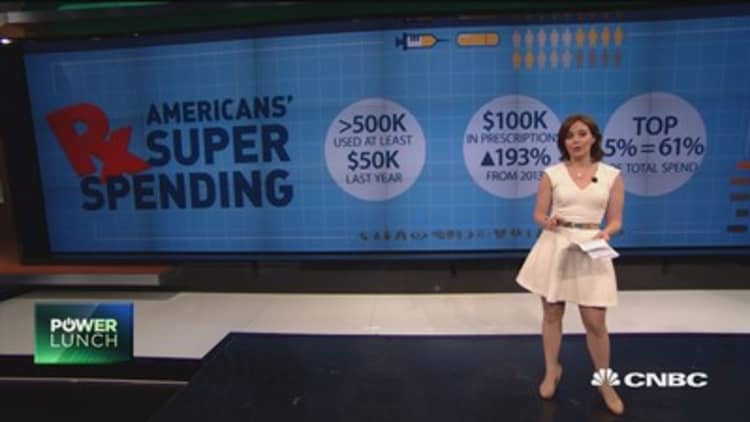
More than half a million Americans have annual prescription drug costs of more than $50,000, according to a study released Wednesday by pharmacy benefits manager Express Scripts.
That's roughly the population of a city approaching the size of Boston, spending more than the median household income in the U.S. on medicine each year. (Tweet This)
More than 100,000 Americans spent more than $100,000 on prescription medicine in 2014, Express Scripts found; that's almost triple the number the year before. Driving the costs for those with the highest expenses: primarily medicines for hepatitis C and cancer, the report showed.
Read MoreWhy do drugs have such weird names?
"The rapid growth in the population of patients with extremely high medication costs threatens the affordability of medical coverage for all beneficiaries and their plan sponsors," wrote Dr. Glen Stettin, senior vice president of clinical, research and new solutions at Express Scripts.
The study examined data from 31.5 million insured Americans from 2013 through 2014. It found that super spenders, those with more than $100,000 or more in medication costs annually, had an average of 98 percent of the total expense covered.
As the largest pharmacy benefits manager in the U.S., Express Scripts helps negotiate drug prices on behalf of its payer clients. It's been waging a war with drug companies over the cost of medicines, starting last year with hepatitis C and more recently turning its eye on new drugs for cholesterol and cancer.
Read MoreIs this hot biotech the next Genentech?
Those medicines, particularly for cancer and hepatitis C, have come under scrutiny from the government, physicians and patient advocacy groups as well for their price tags.
A breakthrough group of medicines for hepatitis C, from Gilead Sciences, AbbVie and Johnson & Johnson, can cost more than $80,000 for a course of treatment. But they cure the disease for the majority of patients, without the unpleasant side effects and injections required with older drugs. The drugmakers argue that lowers total health-care costs down the line.

"The health improvements and cost-savings new medicines provide explain why, despite repeated claims to the contrary, prescription drug spending continues to be a small and declining share of overall health care cost growth—a reality that often gets ignored in the public debate about drug costs," John Castellani, CEO of industry organization PhRMA, said in a statement last year.
Read MoreGovernment cracks whip over birth control rules
The heightened scrutiny comes as spending on cancer drugs in the U.S. hit a milestone last year, topping $100 billion, according to a May 5 report from the IMS Institute for Healthcare Informatics. It noted that, in many cases, survival rates are improving with the new drugs, which can come with prices of more than $10,000 a month.
The average American spent just a fraction of that each year on medication costs: $1,370 in 2014, according to Express Scripts, with an average out of pocket cost of $185, or about 14 percent. Patients in the top 5 percent of spending accounted for 61 percent of the country's medication expenses.
So who is the average super spender? The report found he tends to be an older man. Three in 5 patients with medication costs of more than $100,000 a year were baby boomers, born between 1946 and 1964, with men slightly overrepresented, at 56 percent of the group.
They tend to have multiple maladies: More than a third of the people in the $100,000-plus category were treated for at least 10 conditions last year, while 60 percent were taking at least 10 different prescription medicines.
Blood pressure medications were most commonly taken by both the highest-cost group and the general population, while drugs for hepatitis C and cancer were overrepresented among the super spenders. Compounded medicines—those specially formulated at pharmacies for all types of uses—also contributed to costs for those in the highest echelon, Express Scripts found.
Most patients with the highest medication costs had at least four different prescribers last year; only 4 percent had all their medicines prescribed by the same doctor, "contributing to the complexity and cost of managing several concurrent conditions," the report said.

